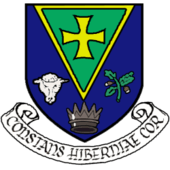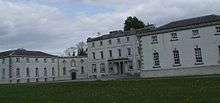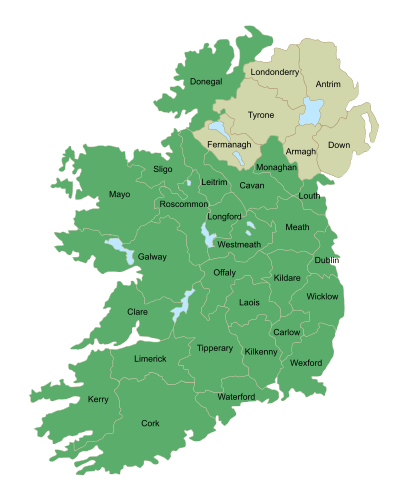County Roscommon
| County Roscommon Contae Ros Comáin | ||
|---|---|---|
| ||
|
Motto: Constans Hiberniae Cor (Latin) "Steadfast Irish heart" | ||
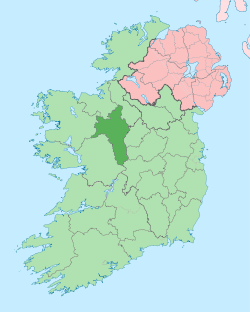 | ||
| Country | Ireland | |
| Province | Connacht | |
| Dáil Éireann | Roscommon–South Leitrim | |
| EU Parliament | Midlands–North-West | |
| County town | Roscommon | |
| Government | ||
| • Type | County Council | |
| Area | ||
| • Total | 2,548 km2 (984 sq mi) | |
| Area rank | 11th | |
| Population (2016) | 64,436 | |
| • Rank | 27th | |
| Vehicle index mark code | RN | |
| Website |
www | |
County Roscommon (Irish: Contae Ros Comáin) is a county in the western region of the Republic of Ireland. It is also part of the province of Connacht. It is the 11th largest Irish county by area and 27th most populous. Its county town and largest town is Roscommon. Roscommon County Council is the local authority for the county. The population of the county is 64,065 according to the 2011 census.[1]
Roscommon has the second least population density after Leitrim.[2] It is the third largest of Connacht’s five counties by size and fourth largest in terms of population. The county borders every other Connacht county - Galway, Mayo, Sligo and Leitrim, as well as three Leinster counties - Longford, Westmeath and Offaly. In 2008, a news report said that statistically, Roscommon has the longest life expectancy of any county on the island of Ireland.[3]
Etymology
County Roscommon is named after the county town of Roscommon. Roscommon comes from the Irish Ros meaning a wooded, gentle height and Comán, the first abbot and bishop of Roscommon who founded the first monastery there in 550 AD.[4]
Geography
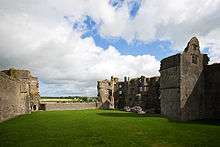
Roscommon is the eleventh largest of the 32 counties of Ireland by area and the fifth least-populous county in Ireland. It has an area of 984 square miles.[5] Lough Key in north Roscommon is noted for having thirty-two islands. The geographical centre of Ireland is located on the western shore of Lough Ree in the south of the county.[6]
Seltannasaggart which is located along the northern border with County Leitrim is the tallest point in County Roscommon measuring to a height of 428 m (1,404 ft).[7]
Baronies
There are nine historical baronies in County Roscommon.
North Roscommon
- Boyle (north Roscommon including Boyle and Arigna).
- Frenchpark (north-west, including Ballaghaderreen and Frenchpark).
- Roscommon (mid-north-east, including Tulsk).
- Castlereagh (west, including Castlerea and Ballinlough).
- Ballintober North (east including Rooskey and Tarmonbarry).
South Roscommon
- Ballymoe shared with County Galway includes Ballymoe, Creggs and Glenamaddy.
- Ballintober South (south-mid-east, including Roscommon).
- Athlone (mid-south, including Knockcroghery and part of Athlone).
- Moycarn (far-south, including part of Ballinasloe).
History

Rathcroghan (Rath Cruachán), near Tulsk, a complex of archaeological sites, the home of Queen Medb (Méadhbh, Maeve), was the seat of Kings of Connacht and then to the High Kings of Ireland. This was the starting point of the Táin Bó Cúailnge, or Cattle Raid of Cooley, an epic tale in Irish mythology.
County Roscommon as an administrative division has its origins in the medieval period. With the conquest and division of the Kingdom of Connacht, those districts in the east retained by King John as "The King's Cantreds" covered County Roscommon, and parts of East Galway. These districts were leased to the native kings of Connacht and eventually became the county. In 1585 during the Tudor re-establishment of counties under the Composition of Connacht, Roscommon was established with the South-west boundary now along the River Suck.
Medieval art
A "well defined" and "original" fine metal workshop was active in county Roscommon in the twelfth century. The 'Cross of Cong', 'the Aghadoe crosier', 'shrine of the Book of Dimma' and the 'shrine of Manchan of Mohill' are grouped together as having been created by Mael Isu Bratain Ui Echach et. al., at the same Roscommon workshop.[8][9][10][11] The workshop has been linked to St. Assicus of Elphin.[12]
Ordnance Survey
John O'Donovan (1806–61), historian and scholar, visited County Roscommon in 1837. He was compiling information for the Ordnance Survey. Entering St. Peter's parish in Athlone in June 1837, he wrote 'I have now entered upon ia region totally different from Longford, and am very much pleased with the intelligence of the people'. But he had major problems with place-names. He later wrote, 'I am sick to death's door of lochawns, and it pains me to the very soul to have to make these remarks, but what can I do when I cannot make the usual progress? Here I am stuck in the mud in the middle of Loughs, Turlaghs, Lahaghs and Curraghs, the names of many of which are only known to a few old men in their immediate neighbourhood and I cannot give many of them utterance from the manner in which they are spelled'.[13][14]

Government and politics
Roscommon is governed locally by the 26 member Roscommon County Council.
For general elections, Roscommon forms part of the three seat Roscommon–South Leitrim constituency.
Sport
Gaelic football is the dominant sport in Roscommon. Roscommon GAA have won 2 All-Ireland Senior Football Championships in 1943 and 1944 and a National Football League Division 1 in 1979 and Division 2 in 2015. Roscommon GAA play home games at Dr. Hyde Park and are close rivals with neighbouring county side, Mayo.
Roscommon has less success in hurling, their main hurling title is the 2007 Nicky Rackard Cup.
People
- Sir John Scott Lillie (1790-1868) CB - decorated Peninsular War veteran, inventor and political activist in England
- Luke O'Connor, the first soldier to receive the Victoria Cross, born in Elphin in 1831
- Chris O'Dowd, Irish actor and comedian, born in Boyle
- John Fitzgibbon (1845-1919) - Member of Parliament
- Baron de Freyne, landlords and residents of Frenchpark House
- Douglas Hyde (1860–1949) - an Irish scholar of the Irish language who served as the first President of Ireland from 1938 to 1945. He founded the Gaelic League, one of the most influential cultural organisations in Ireland. Hyde was born in Castlerea on 17 January 1860 and is buried in the Hyde Museum, Frenchpark, Roscommon.
- Percy French (1854–1920) - one of Ireland's foremost songwriters and entertainers. He has also become recognised for his watercolour paintings.
- Henry Gore-Browne, recipient of the Victoria Cross
- William Griffiths, recipient of the Victoria Cross
- Sir Owen Lloyd, recipient of the Victoria Cross
- Brian O'Doherty, an Irish writer, artist, and art critic in New York City, born in Ballaghaderreen
- Maureen O'Sullivan, Ireland's first international movie star, was born in Boyle, County Roscommon
- Brian Leyden, Irish novelist, short story writer, screenwriter, and documentarian
- Thomas Heazle Parke, Irish explorer, born in Clogher House
- Sir William Wilde, eminent surgeon and innovator and father of Oscar Wilde. Born in Castlerea
- Michael Dockry, member of the Wisconsin State Assembly
See also
- List of abbeys and priories in Ireland (County Roscommon)
- Counties of Ireland
- Lord Lieutenant of Roscommon
- High Sheriff of Roscommon
- Earl of Roscommon
- Midland Great Western Railway
References
- ↑ Census 2011 - County Roscommon Overview
- ↑ Corry, Eoghan (2005). The GAA Book of Lists. Hodder Headline Ireland. pp. 186–191.
- ↑ "Roscommon tops life expectancy study". RTÉ News. Dublin: RTÉ Commercial Enterprises. 12 August 2008. Retrieved 19 August 2009.
- ↑ Walsh, Jane (2016-09-09). "What do Ireland's county names mean?". IrishCentral.com. Retrieved 2016-11-22.
- ↑ "County Roscommon, Ireland". www.irelandwide.com. Retrieved 2016-11-22.
- ↑ http://www.osi.ie/en/faq/faq3.aspx
- ↑ http://mountainviews.ie/summit/698/?PHPSESSID=87tvm76ra11k249hp2l55gf6b2
- ↑ Ó Floinn 1987, pp. 179-187.
- ↑ Hourihane 2012, pp. 225.
- ↑ Edwards 2013, pp. 147.
- ↑ Karkov, Ryan, Farrell 1997, pp. 269.
- ↑ Kelly 1902, pp. 291-292.
- ↑ Hunt, Roy, 'Painful progress: the slow evolution of County Roscommon society, 1850-1914'. Unpublished Thesis, 2010, NUIG p. 8
- ↑ John O' Donovan, 'letters containing information relative to the antiquities of the County of Roscommon, collected during the progress of the Ordnance Survey, 1837. p. 5. Special collections section, National University of Ireland, Galway, 2009 reproduced by Rev. Michael O'Flanagan, Bray 1927
Secondary references
- Ó Floinn, Raghnall (1987). Michael Ryan, ed. "In Ireland and Insular Art A.D. 500–1200: Proceedings of a Conference at University College Cork, 31 October–3 November 1985" (Schools of Metalworking in Eleventh- and Twelfth-Century Ireland ed.). Dublin: Royal Irish Academy, International Specialized Book Service Incorporated: 179–187.
- Hourihane, Colum (2012). The Grove Encyclopedia of Medieval Art and Architecture. Volume 2. OUP USA. p. 225. Retrieved 12 October 2016.
- Edwards, Nancy (2013). The Archaeology of Early Medieval Ireland. Routledge. p. 147. Retrieved 10 October 2016.
- Karkov, Catherine E.; Ryan, Michael; Farrell, Robert T. (1997). "The Insular Tradition: Theory and Practice in Transpersonal Psychotherapy". SUNY Press: 269. Retrieved 10 October 2016.
- Kelly, J. J. (1902). "The Irish Ecclesiastical Record, A monthly journal, under Episcopal Sanction" (PDF) (Volume 11 XI ed.). Dublin: Browne & Nolan, Limited, Nassau-Street: 291–292. Retrieved 10 October 2016.
External links
| Wikivoyage has a travel guide for County Roscommon. |
| Wikimedia Commons has media related to County Roscommon. |
 |
County Sligo |
County Leitrim |
 | |
| County Mayo |
|
County Longford County Westmeath | ||
| ||||
| | ||||
| County Galway |
County Offaly |
Coordinates: 53°45′N 8°15′W / 53.750°N 8.250°W
